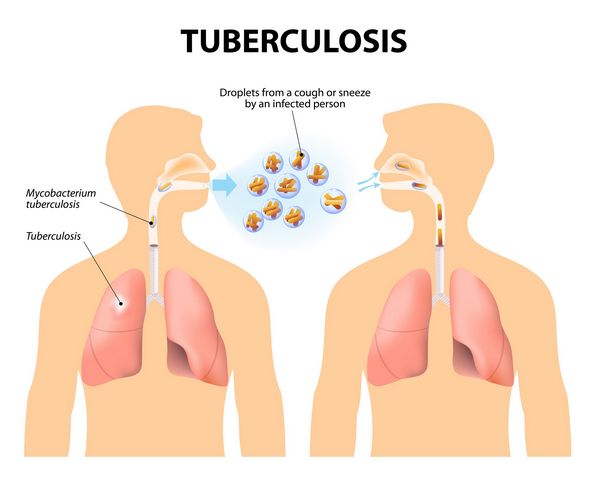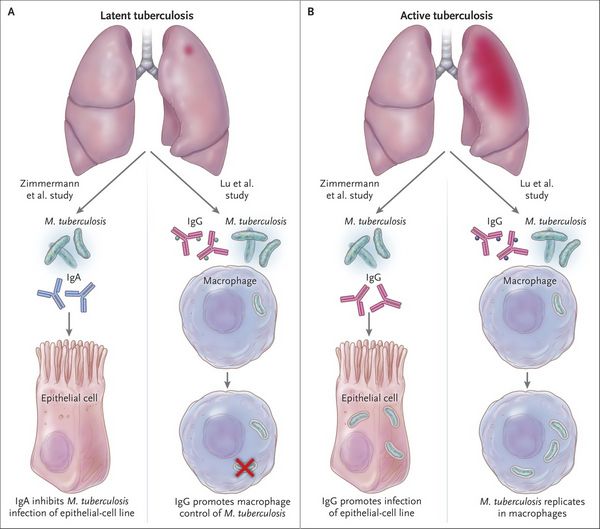Tuberculosis
Active Tuberculosis
Rifapentine is used in conjunction with other antituberculosis agents in the treatment of clinical tuberculosis. The American Thoracic Society (ATS), US Centers for Disease Control and Prevention (CDC), and Infectious Diseases Society of America (IDSA) currently recommend several possible multiple-drug regimens for the treatment of culture-positive pulmonary tuberculosis. These regimens have a minimum duration of 6 months (26 weeks), and consist of an initial intensive phase (2 months) and a continuation phase (usually either 4 or 7 months).
Rifapentine is considered a first-line antituberculosis agent for use in intermittent regimens in patients with pulmonary tuberculosis. Although the manufacturer states that rifapentine can be used in both the initial and continuation phases of tuberculosis treatment, the ATS, CDC, and IDSA suggest that rifapentine not be used in the initial phase of treatment but can be used in certain patients for the continuation phase in a once-weekly regimen in conjunction with isoniazid. The ATS, CDC, and IDSA state that rifapentine can be used in patients with noncavitary pulmonary tuberculosis caused by susceptible Mycobacterium tuberculosis if sputum smears are negative at completion of the initial treatment phase, but the drug should not be used for the treatment of tuberculosis in individuals with human immunodeficiency virus (HIV) infection and, because of limited experience, should not be used in those with extrapulmonary tuberculosis.

Clinical Experience
Safety and efficacy of rifapentine is based on a large, controlled international trial comparing the drug with rifampin in patients with pulmonary tuberculosis who received either drug concomitantly with at least one other antituberculosis agent in a regimen that consisted of an intensive phase for 2 months and a continuation phase for 4 subsequent months; all patients received pyridoxine (vitamin B6) throughout the 6-month trial.
The intensive phase of therapy included either rifapentine (600 mg twice weekly) or rifampin (450 or 600 mg daily depending on body weight) given in conjunction with isoniazid (300 mg daily), pyrazinamide (1. or 2 g daily depending on body weight), and ethambutol (800 mg or 1.2 g daily depending on body weight). The continuation phase of therapy (subsequent 4 months) evaluated a drug regimen consisting of rifapentine (600 mg once weekly) and isoniazid (600 or 900 mg once weekly depending on body weight) or a regimen of rifampin (450 or 600 mg twice weekly depending on body weight) and isoniazid (600 or 900 mg once weekly depending on body weight); pyrazinamide and ethambutol were discontinued. Sputum converted to negative in 87% of patients with tuberculosis receiving rifapentine-containing drug regimens and in 81% of patients receiving rifampin-containing regimens by the end of 6 months of therapy.
Although rifapentine also has been studied in China and Hong Kong, the results of these studies were less than optimal since the oral formulation used produced low and variable bioavailability.

Because rifapentine has a long half-life and can be administered intermittently (once weekly for the continuation phase or twice weekly for the intensive phase), some clinicians suggest that the drug may be particularly useful when patient compliance is a concern. In addition, intermittent rifapentine therapy may have operational advantages in implementing directly observed therapy.
However, additional study and experience are needed to elucidate further the role of rifapentine vs. rifampin in multiple-drug regimens for the treatment of tuberculosis, particularly because of concerns about relapse. The rate of relapse (reactivation of clinical tuberculosis) was higher in patients receiving rifapentine versus rifampin combination therapy, principally as a result of a higher rate of patient noncompliance with daily concomitant therapies during the intensive phase in rifapentine-treated patients.
Failure for sputum to convert to negative during the intensive phase of short-course therapy also was associated with a greater risk of relapse for either treatment regimen as was male gender.
Relapse or treatment failure at 6 months of follow-up occurred in 10% of patients receiving the rifapentine-containing regimens and in 5% of those receiving the rifampin-containing regimens. A small proportion of patients relapsing had in vitro evidence of rifampin- and rifapentine-resistant (genetic differences from baseline strains based on restriction fragment length polymorphism) or multidrug-resistant strains of tuberculosis.
However, relapses in patients receiving rifapentine were not associated with mono-resistance to rifampin.
HIV-infected Individuals
Experience with rifapentine in patients with HIV infection and tuberculosis is limited, and the ATS, CDC, and IDSA state that use of the drug in antituberculosis regimens in such patients currently is not recommended. In an ongoing small clinical trial in patients with HIV infection and tuberculosis who were randomized to receive once-weekly rifapentine and daily isoniazid during the continuation phase (months 3-6) of therapy, the relapse rate was about twice that observed in HIV-negative patients with tuberculosis.
Almost all (4 out of 5) cases of relapse in these HIV-infected patients who received rifapentine were associated with rifampin-resistant tuberculosis; relapse also was associated with late stages of HIV infection (e.g., lower CD4+ T-cell counts compared with those whose disease did not relapse), extrapulmonary tuberculosis, and concomitant therapy with an azole-derivative antifungal. As with other antituberculosis agents used in HIV-infected patients, if rifapentine is used, a more aggressive (i.e., more frequent dosing) rifapentine-containing regimen should be employed during the continuation phase of short-course therapy.
Based on these limited findings, once-weekly rifapentine dosing during the continuation phase of therapy should not be employed in HIV-infected patients. In addition, the possibility that drug regimens may have to be altered because of clinically important pharmacokinetic interactions between rifapentine and other drugs commonly used in these patients (e.g., HIV protease inhibitors such as indinavir, nelfinavir, ritonavir, saquinavir; azole antifungals; reverse transcriptase inhibitors) should be considered.
The manufacturer recommends that rifapentine be used with extreme caution, if at all, in patients who are receiving an HIV protease inhibitor.
Because the management of these patients is complex and must be individualized, experts in the management of mycobacterial infections in HIV-infected patients should be consulted. If tuberculosis is diagnosed in an HIV-infected patient in whom use of an HIV protease inhibitor is being considered but has not yet been initiated, a management strategy suggested by CDC is to complete the treatment of tuberculosis according to current ATS and CDC guidelines before adding the HIV protease inhibitor to the patient’s antiretroviral regimen.
In HIV-infected patients who already are receiving an HIV protease inhibitor when tuberculosis is diagnosed, the CDC has suggested several options for consideration.
However, because the risks and benefits of these options are unknown, management decisions must be individualized on a case-by-case basis to provide optimal patient care.

